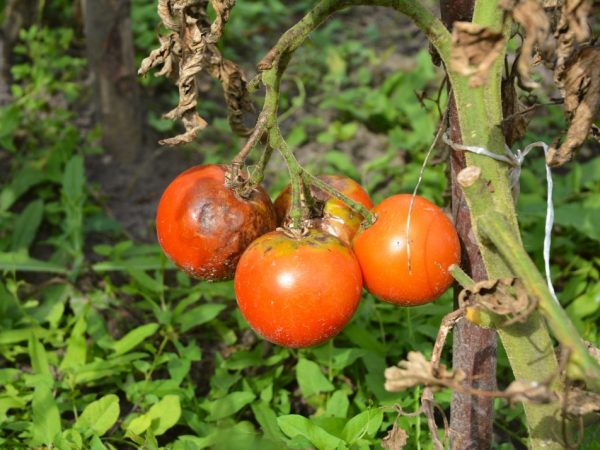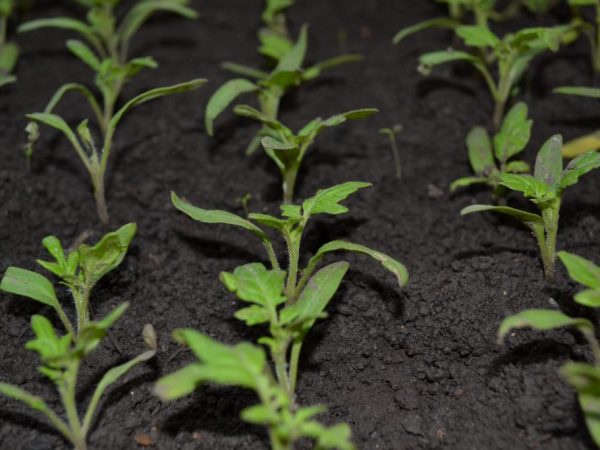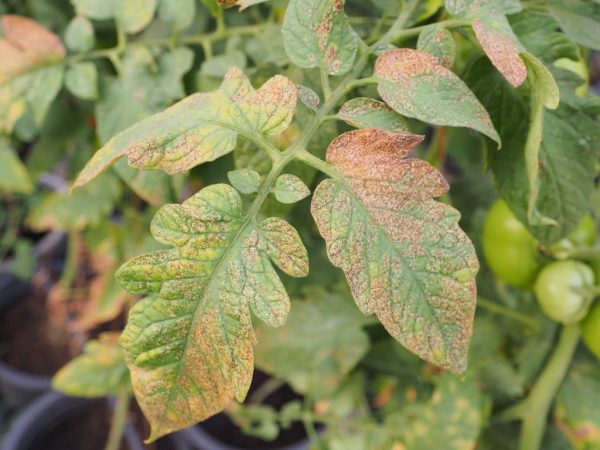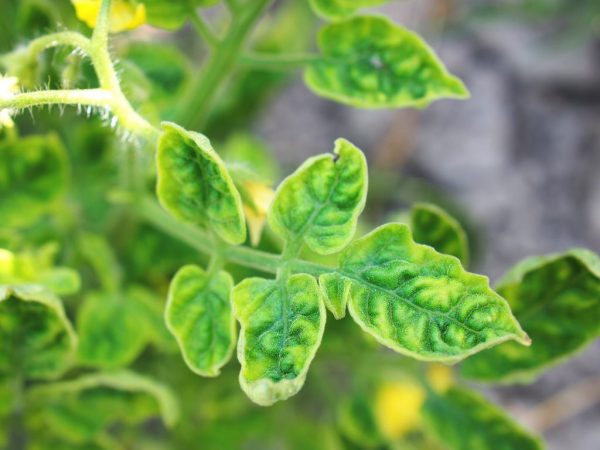Diseases and pests of tomato seedlings and their treatment
Diseases of tomato seedlings are a common problem. Consider what types of diseases can affect a plant and how to deal with ailments.

Diseases of tomato seedlings and their treatment
Types of diseases
Tomato seedlings are susceptible to both fungal and viral diseases, and also suffer from insect attacks. Among the most common causes of the disease of the bushes are:
- fungal diseases;
- viral diseases;
- damage by pests.
Fungal diseases
- late blight;
- blackleg.
These diseases are triggered by different factors, and the methods of their treatment are also different.
Late blight
Late blight is a disease that is transmitted through the seeds of infected crops, soil and airborne droplets.
A close examination of the sprouts helps to determine what exactly the tomato seedlings are sick with. The onset of late blight manifests itself as follows:
- dark brown spots appear on the leaves;
- the reverse side of the sheet plate is covered with a grayish bloom;
- the spots are transferred to the stems.
Late blight quickly infects all plantings. If you don't take action, you can lose your harvest.
How to avoid the problem
Treatment of tomato sprout disease begins with prevention:
- Protection against late blight begins with the processing of seed. A pink solution is used to disinfect seeds. The concentration of manganese in the composition should not exceed 1–2%. The seeds are soaked in this solution and left for 2-3 hours. Hydrogen peroxide is also used to disinfect seeds.
- The optimum moisture content for tomato seedlings should not exceed 75%. The room is ventilated. Carrying out such events, they do not allow drafts.
- Plants that have at least 2 true leaves are treated with disinfectant solutions.
- They respect the correct neighborhood of cultures. For tomatoes, the best neighbors are garlic, onions, cabbage, radish, lettuce, and beans.
- When planting tomatoes, observe the distances between rows and holes.
As a preventive measure, special chemicals are used Oxyhom, Metronidazole, Fitosporin, Trichopol, Barrier. Vegetable growers recommend using Bordeaux liquid, copper sulfate. All drugs are used strictly in accordance with the manufacturer's instructions.
Traditional methods of treatment
From the folk methods of combating late blight, an effective remedy is used - a solution of manganese with garlic. This infusion requires 200 g of chopped garlic and 1 g of manganese. The mixture is poured into 1 liter of water, insisted for 48 hours. The resulting product is filtered, the volume is brought to 10 liters. The solution is ready for plant treatment.
Tatiana Orlova (Candidate of Agricultural Sciences):
Late blight is a disease that predominantly affects adult tomato and potato plants, but not seedlings.
Blackleg

The disease can rob seedlings
Pathogenic fungi that provoke the development of blackleg in tomatoes live in the soil, so the soil is treated before planting the tomatoes.For this, the prepared soil mixture is calcined at a temperature of at least 100 ° C, and then spilled with a manganese solution.
The reasons for the development of tomato seedling disease can be:
- high air temperature;
- waterlogging of the soil.
Withering of seedlings signals that the culture is sick. This is accompanied by a blackening of the stem just above the root. The sprouts become thin and dry out gradually.
Treatment methods
Diseased seedlings are destroyed. The places of the removed shoots are sprinkled with wood ash. The area of the entire bed is covered with calcined river sand. The sand layer must be at least 2 cm.
To combat the black leg, Fitolavin, Bactofit, Fitosporin are used. The use of any drug is carried out strictly in accordance with the instructions.
Tatiana Orlova (Candidate of Agricultural Sciences):
At the first signs of the appearance of a black leg (1-2 "fallen" seedlings), watering is sharply reduced, the surface of the seedling box is sprinkled with powdered charcoal or crushed tablets of activated carbon.
Viral
Viral diseases of tomatoes include:
- white spot;
- brown spot:
- streak;
- mosaic;
- aspermia.
White spot
Tomato white spot, or septoria, begins with the defeat of the lower leaves of the seedlings. On close inspection of the seedlings, you can see white specks of grayish shades and with small black blotches. Later, the leaf plate acquires a brown hue, dries up and disappears. The disease rises up the stem and leaves.
Treatment methods
To combat white spot, a 1% solution of Bordeaux liquid is used. If the treatment does not help, the affected plants are removed, and the places of their growth are sprinkled with wood ash.
Prophylaxis
To prevent the culture from getting sick, preventive measures are taken, which consist in pre-processing the soil. In the fight against fungi of septoria, a good result is shown by the freezing of the soil in which it is planned to grow tomatoes. It will be useful to treat the soil with a 1% solution of manganese, fertilize with sand and ash.
Brown spot

Diseased parts of the plant must be removed
Brown spotting of tomatoes appears with yellow spots with a grayish tinge on the front side of the leaves, an olive bloom appears on the back side. Then small specks merge into one large one, the leaf plate becomes brown on top, and the plaque on the underside acquires a reddish tint with brown splashes. The development of the disease leads to the death of tomato seedlings.
Treatment methods
If the culture is sick, the infected shoots are removed, the beds are sprinkled with ash and river sand, the plantings are treated with Bordeaux liquid or solutions based on copper-containing preparations.
Prophylaxis
It is best to start the fight against brown spot with the prevention of the disease. To do this, thoroughly cultivate the soil using a pink solution.
Streak
The disease spreads through seeds. Streak appears on the leaves, stems of seedlings with red-brown stripes, strokes and specks. A plant that is sick becomes fragile, brittle. Leaves on such a culture are gradually dying off.
Treatment methods
Damaged shoots are removed from the beds. The beds are treated with a manganese solution, fertilized with wood ash.
Prophylaxis
Streak prevention begins with careful preparation of the seed.
- get quality seeds;
- do not use seeds of diseased crops;
- the seed is kept in a pink solution for 2-3 hours.
Mosaic
The disease manifests itself as variegated spots on all leaves. Further development of the disease leads to the fact that the leaf plates become wrinkled, curl, gradually acquire a yellow color and die off. Insect pests are the vectors of the disease.
Treatment methods
For the treatment of mosaics, a 10% solution of milk whey is used.Pharmayod has proven itself well among the chemicals used to combat mosaics. It will not be superfluous to treat tomato plantings with insecticides.
The mosaic spreads rapidly over the tomato plantings. The rules of agricultural technology cannot be neglected:
- remove weeds;
- follow the scheme for planting tomatoes;
- provide enough light for plantings;
- do not overmoisten the soil.
Prophylaxis
Prevention of the disease consists in the correct preparation of seed and soil:
- choose seeds that are 2-3 years old;
- process seeds with a 20% hydrochloric acid solution;
- sterilize the soil;
- disinfect garden tools.
After the appearance of the first shoots, plant prophylaxis continues. These activities consist in processing the sprouts with a weakly concentrated solution of boric acid.
Aspermia

Insects are the cause of the disease
Among the diseases that are ill with tomato seedlings, a viral disease - aspermia (infertility) - occupies a special place. This virus is transmitted by insects or plants, which are reservoirs for these microorganisms. The disease manifests itself in the increased curliness of the tops. The stem of the culture does not develop, the leaves curl, become small, acquire an irregular shape, and the plant does not bear fruit.
Treatment methods
The fight against the virus is primarily in the treatment of plants from such pests as aphids (the first vector of the virus). The following chemical fungicidal preparations are used:
- Bison;
- Agravertine,
- Actellik,
- Akarin,
- Intavir.
All solutions must be prepared strictly in accordance with the instructions for the preparation, otherwise there is a risk of harming the plants.
Prophylaxis
Taking preventive measures will reduce the risk of developing diseases. These measures include:
- insecticide treatment;
- observance of the correct neighborhood of cultures;
- disinfection of seed material.
Pests
- aphid;
- whitefly;
- thrips;
- garden scoop.
Aphids and whiteflies
Whitefly and aphids pose a great threat as vectors of diseases.
Treatment methods
The use of insecticides and soap solutions on tomato plantings will help get rid of such pests.
Thrips
Thrips are hidden on the underside of leaves or in buds. As a result, the leaves dry out and die off.
How to fight
In the fight against them, drugs Aktara, Fitoverm will help.
Scoops
The moth caterpillars stick to young shoots and feed on the juice of the shoots until it dies.
How to fight
The fight against such pests is as follows:
- dig up land plots in the fall;
- remove plant debris before planting;
- remove weeds throughout the entire period of crop development;
- catch the caterpillars by hand;
- use sweet traps.
Chemicals can be used. In spring, plants are treated with insecticides (Karate, Decis, Zolon). For processing the rest of the time, Aktofit, Agrortin are suitable.
Conclusion
If you know why tomato seedlings are sick, it will be much easier to deal with the problem. In order to harvest a good harvest, they create favorable conditions for the development of the culture, monitor all changes in the sprouts, and take measures to eliminate the symptoms of diseases.



